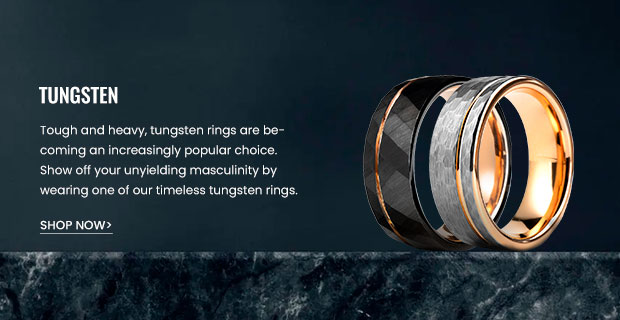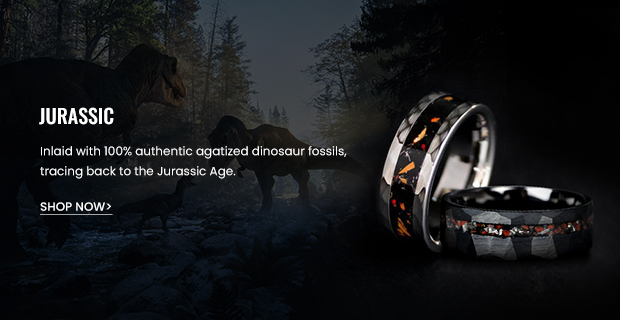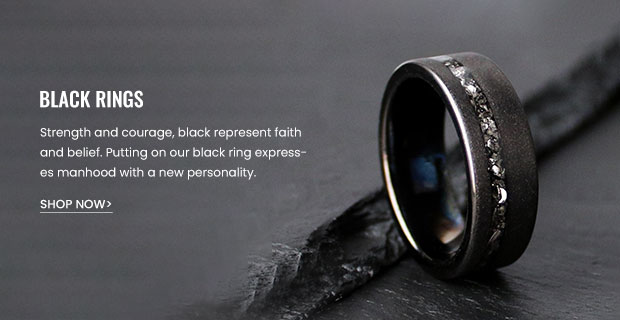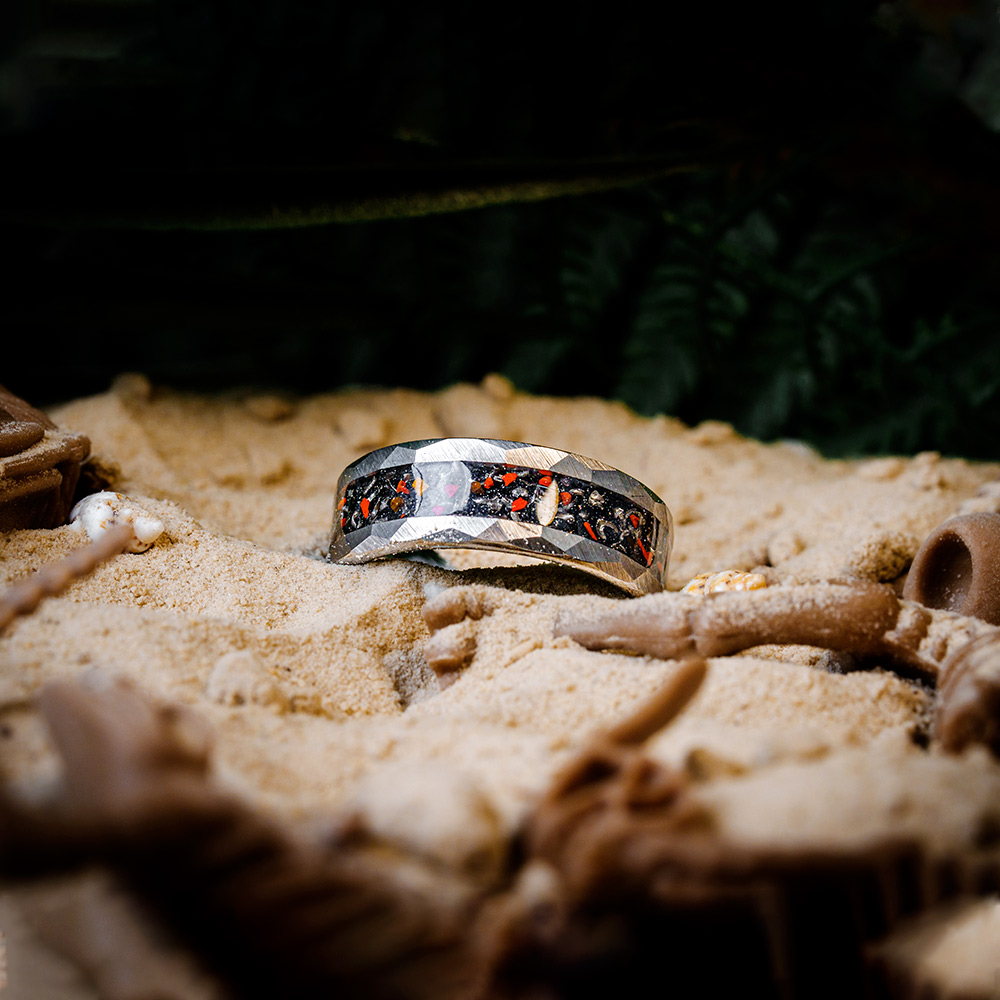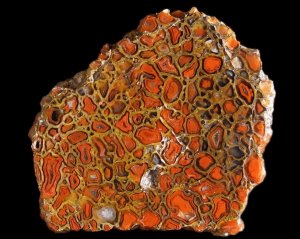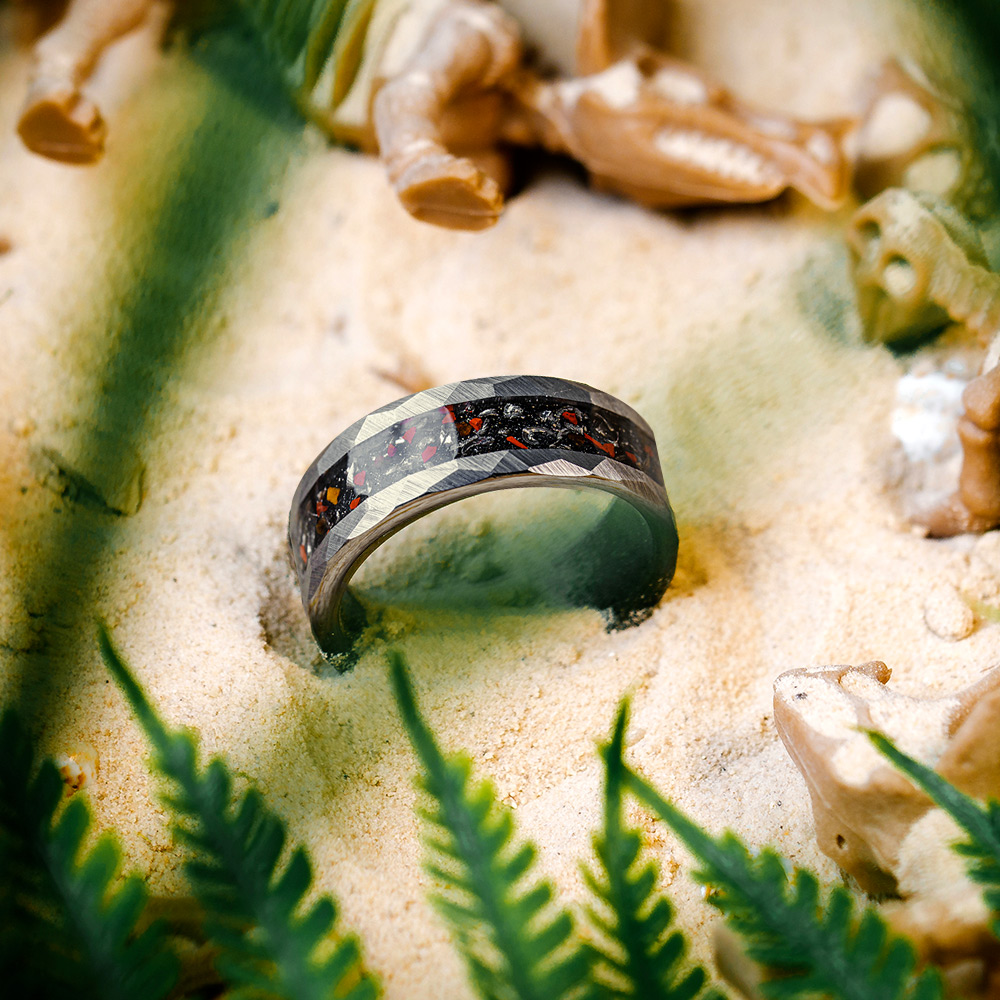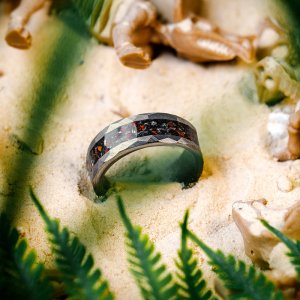Are you fascinated by Dinosaur bone rings but hesitant to take the next step? Do you want to know are Dinosaur bone rings real? Did the uncertainty and variety leave you more confused than before?
Read ahead to learn everything about the history, truth, and authenticity of dinosaur bone rings that make the perfect wedding band.
What Does Gem Bone Look Like?
An agatized dinosaur bone in its raw form looks like any other typical rock. The unique patterns and the color variation uncover once they are carefully cut and polished.
For millions of years, each dinosaur bone ring underwent considerable heat, pressure, and intrusions from other chemicals. For this reason, they all vary in appearance. It can be tan, black, red, blue, or even pink. Plus it can be the best wedding ring.
The color depends on the minerals that were present in the geological era. The three most important eras— Triassic, Jurassic, and cretaceous periods had completely different environments and chemical make-up. This makes the fossilized bones from each period highly distinguished. One fine example is the Gibeon meteorite.
Even from the same era, dinosaur bone jewelry can vary considerably in its color, pattern, shine, and speckles.
Here are some of the key features of a gem bone after it is polished:
Crystalline Patterns
Although this is not always present, it is a highly popular aesthetic when it comes to gem bone rings.
The crystalline pattern is the result of groundwater that mineralizes the bones over the years. When looked at carefully, the gem bone has a stony appearance with multiple dimensions, just like crystals. Crystalline patterns are usually common on manly bands.
Unique Speckles
Each gem bone engagement ring is created as a result of hundreds of unique minerals interacting with it. These can include tiny bits of agate, jasper, calcite, sterling silver and many more colorful minerals. The diverse combination of minerals results in randomized speckles of color, which can be red, silver, blue, or any other color. In the United States you will find a lot of dinosaur jewelry with unique speckles.
Marble-like appearance
Water makes an important part of dinosaur bone fossilization. The aqueous interactions with dinosaur fossils results in a widely dispersed color pattern that can look like colorful ink moving freely.
Because of this, the gem bones often have an appearance that resembles that of marbles.
How Do Dinosaur Bones Get Fossilized?
The truth is that the bones of prehistoric animals were mostly decomposed and consumed by other animals and bacteria. We can take the example of an agatized dinosaur fossil.
Only a rare few met the perfect conditions that allow for fossilization. This subset is fossilized by a specific type of environmental and geological condition known as the aqueous intrusion. It occurs bit by bit until the remaining element of the bone— more clearly known as the calcite— is replaced with silicates.
As the bones become weaker and more porous, groundwater can find its way inside the fossilized bone and gradually begin the mineralization process.
The result is a beautifully patterned fossil that was once the bones of a dinosaur.
Dinosaur Bone Rings: What Are They Made Of?
Dinosaur bone rings are crafted with smaller, broken, or dispersed pieces of dinosaur bones. These are isolated pieces that can’t be used as scientific specimens.
Although they survived millions of years buried under the earth’s layers, they are extremely fragile. For this reason, the rings are made with crushed pieces of bone rather than an intact slab. This ensures that a sudden shock, collision, or fall doesn’t damage the visual appeal.
Compared to other high-end jewelry pieces, a dinosaur ring can only be crafted with an inlay design. Some amount of resin is also used to lock the bits of bones into place, which also gives it a shinier appearance like gold.
Are Dinosaur Bone Rings Real?
With dinosaurs being extinct for over 200 million years, it’s fine to assume that their bones don’t really exist anymore. While it’s true that dinosaur bones in their all-natural and raw form don’t exist, their fossilized remains do and look like white gold.
Dino bone rings are made with authentic dinosaur bones that fossilized over millions of years and formed highly distinguished patterns.
They can originate from various prehistoric eras, including the Triassic, Jurassic, and Cretaceous Periods. Each geological era lasted for at least 50 million years. This makes the associated fossilized bones incredibly diverse in chemical composition and visual appeal. Anyone can find a variety of these rings in a field museum.
When you buy a dinosaur bone ring, what you actually receive is a new state of dinosaur bone that has been transformed into unique crystalline patterns. These include randomized patterns, speckles of inclusions, and contrasting colors that modern tech can’t emulate.
How do I know If a Dinosaur Bone Ring Is Real?
There is no foolproof method of testing authenticity. The mineralized structure of dinosaur bones looks exactly like any other prehistoric bone. Besides these, every bone mineralizes differently, resulting in one-of-a-kind colors, patterns, and contrasts. This makes authentication even harder.
You may be able to get an expert’s opinion, but there are no tests you can conduct. Your best bet is to pick a trustworthy vendor with a proven track record of delivering authentic rings.
Final Words
Dinosaur bone rings are truly extraordinary and offer an element of personalization that isn’t found elsewhere. The range of colors and paired metals make picking the perfect ring as easy as it gets. However, their authenticity can be a reasonable question. Picking a vendor that offers a certificate of authenticity can ensure that you get an authentic piece.

